CRM Strategies for Growth: Analyzing Sampath Bank PLC Performance
VerifiedAdded on 2023/05/29
|33
|7714
|78
Report
AI Summary
This report provides an in-depth analysis of Sampath Bank PLC (SBPLC), focusing on the impact of Customer Relationship Management (CRM) on its growth, the influence of macro environmental factors (political and technological), and its approach to disruptive innovation. The report begins with an overview of SBPLC's background, including its size, products, services, customer base, and key competitors. It then examines how political instability and technological advancements have affected SBPLC, particularly in terms of non-performing assets and digital banking strategies. Furthermore, the report assesses SBPLC's innovation strategies, comparing them with competitors like Commercial Bank PLC, and evaluates the risks and impacts of various disruptive innovations. The report also includes an innovation audit analyzing culture, agility, skills, leadership, and resources for increasing competitive advantage through CRM, highlighting the need for improved research and development and decentralized decision-making.
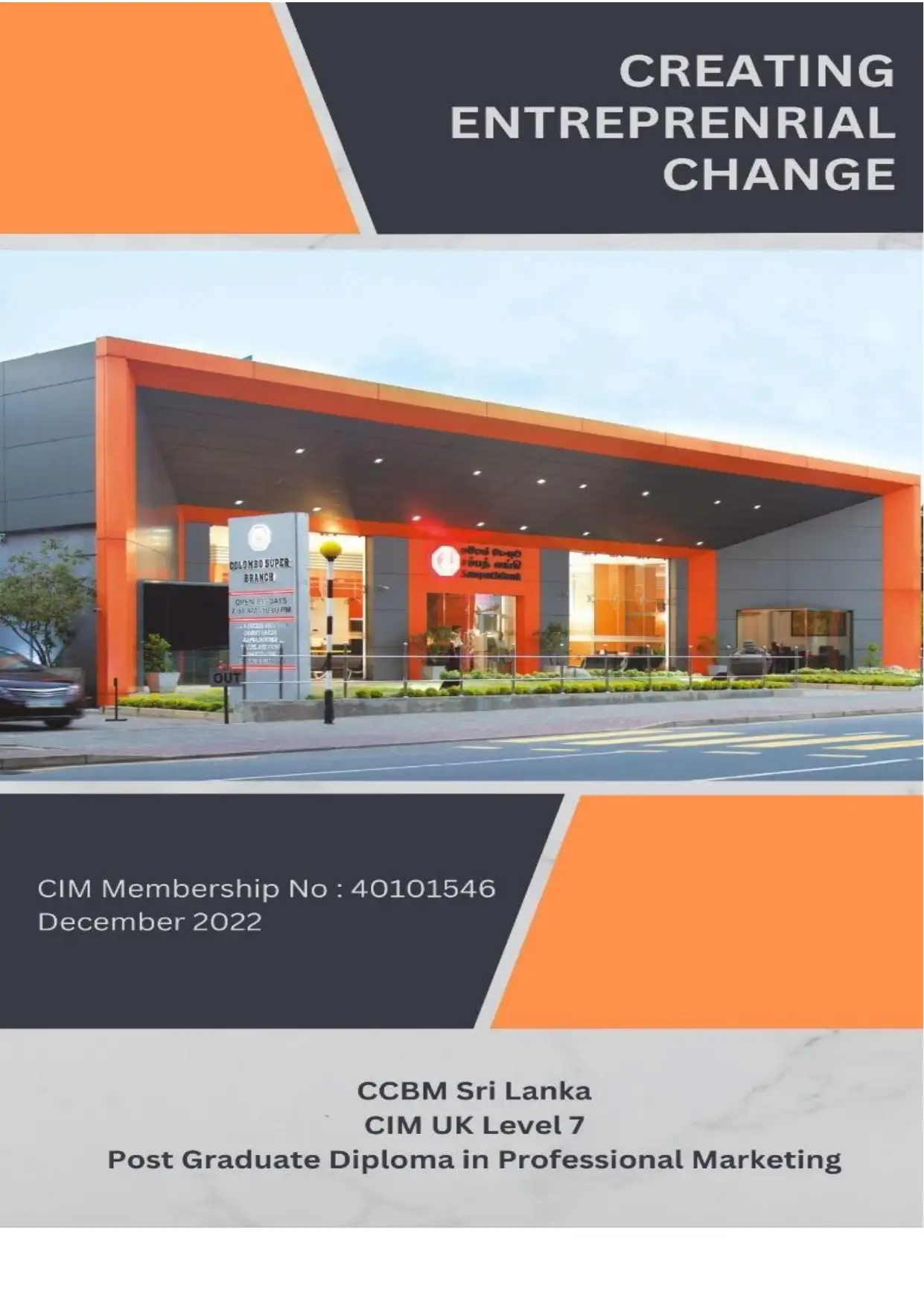
0 | P a g e
Paraphrase This Document
Need a fresh take? Get an instant paraphrase of this document with our AI Paraphraser
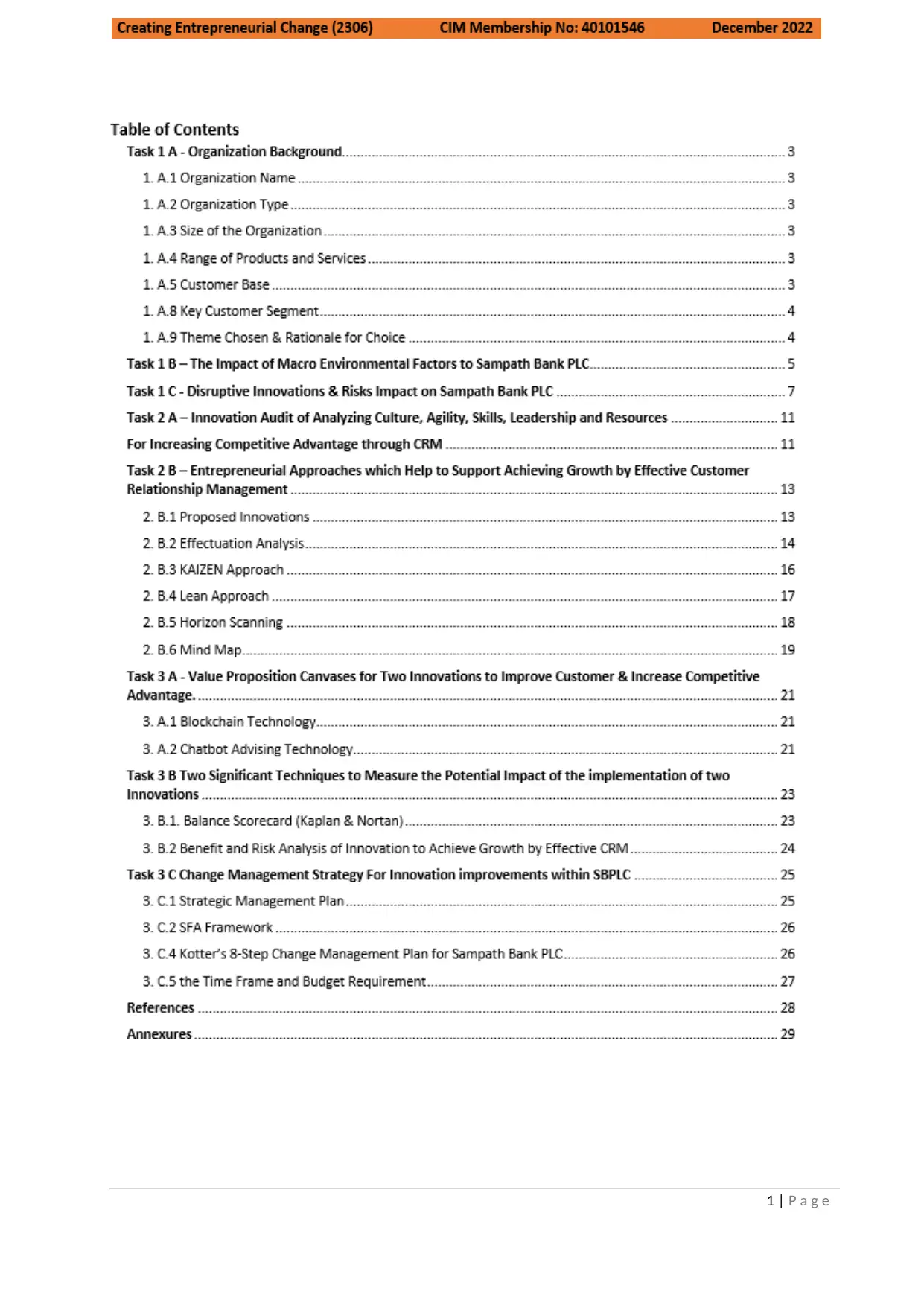
1 | P a g e
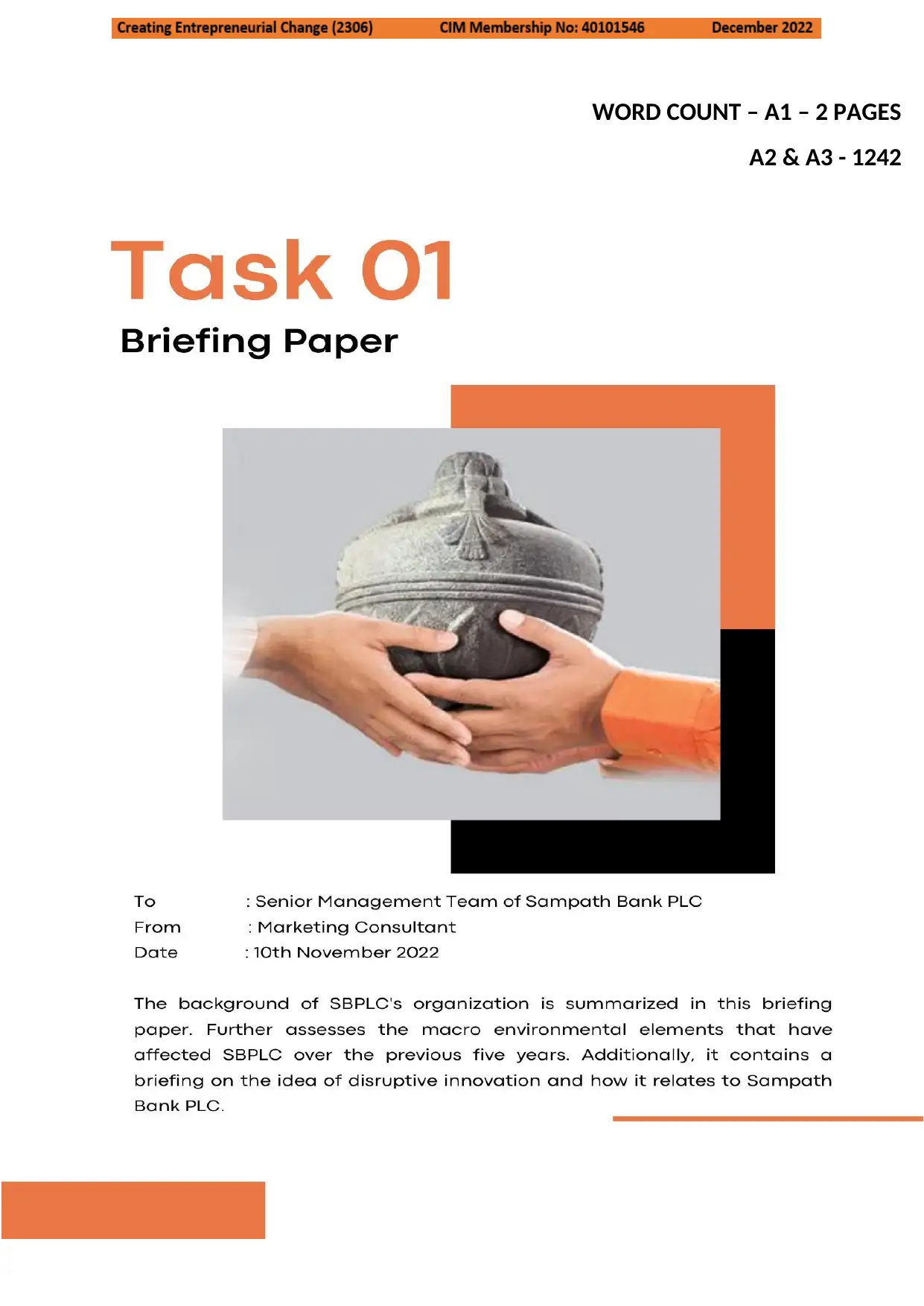
2 | P a g e
WORD COUNT – A1 – 2 PAGES
A2 & A3 - 1242
WORD COUNT – A1 – 2 PAGES
A2 & A3 - 1242
⊘ This is a preview!⊘
Do you want full access?
Subscribe today to unlock all pages.

Trusted by 1+ million students worldwide
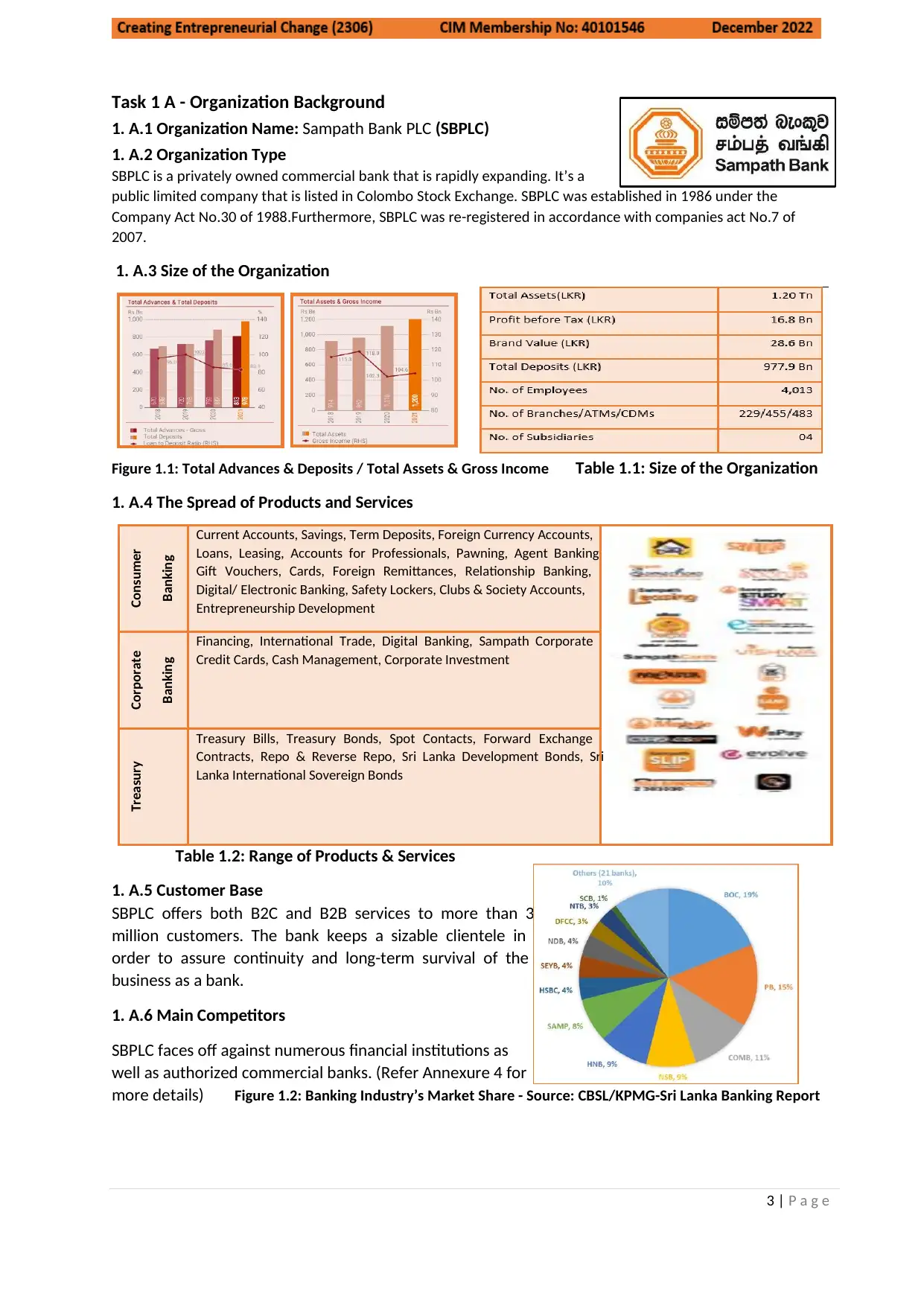
3 | P a g e
Task 1 A - Organization Background
1. A.1 Organization Name: Sampath Bank PLC (SBPLC)
1. A.2 Organization Type
SBPLC is a privately owned commercial bank that is rapidly expanding. It’s a
public limited company that is listed in Colombo Stock Exchange. SBPLC was established in 1986 under the
Company Act No.30 of 1988.Furthermore, SBPLC was re-registered in accordance with companies act No.7 of
2007.
1. A.3 Size of the Organization
Figure 1.1: Total Advances & Deposits / Total Assets & Gross Income Table 1.1: Size of the Organization
1. A.4 The Spread of Products and Services
Table 1.2: Range of Products & Services
1. A.5 Customer Base
SBPLC offers both B2C and B2B services to more than 3
million customers. The bank keeps a sizable clientele in
order to assure continuity and long-term survival of the
business as a bank.
1. A.6 Main Competitors
SBPLC faces off against numerous financial institutions as
well as authorized commercial banks. (Refer Annexure 4 for
more details) Figure 1.2: Banking Industry’s Market Share - Source: CBSL/KPMG-Sri Lanka Banking Report
Consumer
Banking
Current Accounts, Savings, Term Deposits, Foreign Currency Accounts,
Loans, Leasing, Accounts for Professionals, Pawning, Agent Banking,
Gift Vouchers, Cards, Foreign Remittances, Relationship Banking,
Digital/ Electronic Banking, Safety Lockers, Clubs & Society Accounts,
Entrepreneurship Development
Corporate
Banking Financing, International Trade, Digital Banking, Sampath Corporate
Credit Cards, Cash Management, Corporate Investment
Treasury
Treasury Bills, Treasury Bonds, Spot Contacts, Forward Exchange
Contracts, Repo & Reverse Repo, Sri Lanka Development Bonds, Sri
Lanka International Sovereign Bonds
Task 1 A - Organization Background
1. A.1 Organization Name: Sampath Bank PLC (SBPLC)
1. A.2 Organization Type
SBPLC is a privately owned commercial bank that is rapidly expanding. It’s a
public limited company that is listed in Colombo Stock Exchange. SBPLC was established in 1986 under the
Company Act No.30 of 1988.Furthermore, SBPLC was re-registered in accordance with companies act No.7 of
2007.
1. A.3 Size of the Organization
Figure 1.1: Total Advances & Deposits / Total Assets & Gross Income Table 1.1: Size of the Organization
1. A.4 The Spread of Products and Services
Table 1.2: Range of Products & Services
1. A.5 Customer Base
SBPLC offers both B2C and B2B services to more than 3
million customers. The bank keeps a sizable clientele in
order to assure continuity and long-term survival of the
business as a bank.
1. A.6 Main Competitors
SBPLC faces off against numerous financial institutions as
well as authorized commercial banks. (Refer Annexure 4 for
more details) Figure 1.2: Banking Industry’s Market Share - Source: CBSL/KPMG-Sri Lanka Banking Report
Consumer
Banking
Current Accounts, Savings, Term Deposits, Foreign Currency Accounts,
Loans, Leasing, Accounts for Professionals, Pawning, Agent Banking,
Gift Vouchers, Cards, Foreign Remittances, Relationship Banking,
Digital/ Electronic Banking, Safety Lockers, Clubs & Society Accounts,
Entrepreneurship Development
Corporate
Banking Financing, International Trade, Digital Banking, Sampath Corporate
Credit Cards, Cash Management, Corporate Investment
Treasury
Treasury Bills, Treasury Bonds, Spot Contacts, Forward Exchange
Contracts, Repo & Reverse Repo, Sri Lanka Development Bonds, Sri
Lanka International Sovereign Bonds
Paraphrase This Document
Need a fresh take? Get an instant paraphrase of this document with our AI Paraphraser
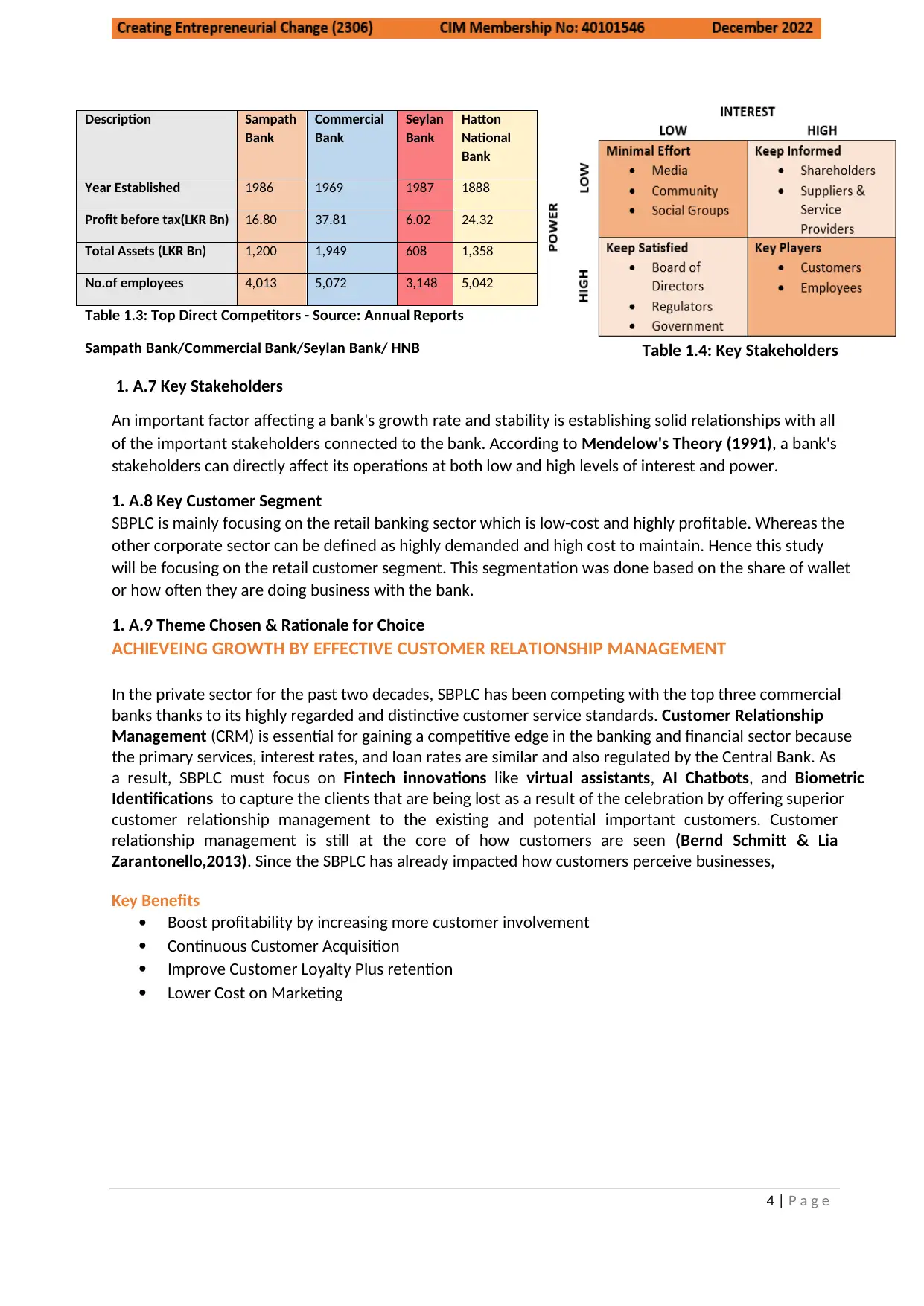
4 | P a g e
Table 1.4: Key Stakeholders
1. A.7 Key Stakeholders
An important factor affecting a bank's growth rate and stability is establishing solid relationships with all
of the important stakeholders connected to the bank. According to Mendelow's Theory (1991), a bank's
stakeholders can directly affect its operations at both low and high levels of interest and power.
1. A.8 Key Customer Segment
SBPLC is mainly focusing on the retail banking sector which is low-cost and highly profitable. Whereas the
other corporate sector can be defined as highly demanded and high cost to maintain. Hence this study
will be focusing on the retail customer segment. This segmentation was done based on the share of wallet
or how often they are doing business with the bank.
1. A.9 Theme Chosen & Rationale for Choice
ACHIEVEING GROWTH BY EFFECTIVE CUSTOMER RELATIONSHIP MANAGEMENT
In the private sector for the past two decades, SBPLC has been competing with the top three commercial
banks thanks to its highly regarded and distinctive customer service standards. Customer Relationship
Management (CRM) is essential for gaining a competitive edge in the banking and financial sector because
the primary services, interest rates, and loan rates are similar and also regulated by the Central Bank. As
a result, SBPLC must focus on Fintech innovations like virtual assistants, AI Chatbots, and Biometric
Identifications to capture the clients that are being lost as a result of the celebration by offering superior
customer relationship management to the existing and potential important customers. Customer
relationship management is still at the core of how customers are seen (Bernd Schmitt & Lia
Zarantonello,2013). Since the SBPLC has already impacted how customers perceive businesses,
Key Benefits
Boost profitability by increasing more customer involvement
Continuous Customer Acquisition
Improve Customer Loyalty Plus retention
Lower Cost on Marketing
Description Sampath
Bank
Commercial
Bank
Seylan
Bank
Hatton
National
Bank
Year Established 1986 1969 1987 1888
Profit before tax(LKR Bn) 16.80 37.81 6.02 24.32
Total Assets (LKR Bn) 1,200 1,949 608 1,358
No.of employees 4,013 5,072 3,148 5,042
Table 1.3: Top Direct Competitors - Source: Annual Reports
Sampath Bank/Commercial Bank/Seylan Bank/ HNB
Table 1.4: Key Stakeholders
1. A.7 Key Stakeholders
An important factor affecting a bank's growth rate and stability is establishing solid relationships with all
of the important stakeholders connected to the bank. According to Mendelow's Theory (1991), a bank's
stakeholders can directly affect its operations at both low and high levels of interest and power.
1. A.8 Key Customer Segment
SBPLC is mainly focusing on the retail banking sector which is low-cost and highly profitable. Whereas the
other corporate sector can be defined as highly demanded and high cost to maintain. Hence this study
will be focusing on the retail customer segment. This segmentation was done based on the share of wallet
or how often they are doing business with the bank.
1. A.9 Theme Chosen & Rationale for Choice
ACHIEVEING GROWTH BY EFFECTIVE CUSTOMER RELATIONSHIP MANAGEMENT
In the private sector for the past two decades, SBPLC has been competing with the top three commercial
banks thanks to its highly regarded and distinctive customer service standards. Customer Relationship
Management (CRM) is essential for gaining a competitive edge in the banking and financial sector because
the primary services, interest rates, and loan rates are similar and also regulated by the Central Bank. As
a result, SBPLC must focus on Fintech innovations like virtual assistants, AI Chatbots, and Biometric
Identifications to capture the clients that are being lost as a result of the celebration by offering superior
customer relationship management to the existing and potential important customers. Customer
relationship management is still at the core of how customers are seen (Bernd Schmitt & Lia
Zarantonello,2013). Since the SBPLC has already impacted how customers perceive businesses,
Key Benefits
Boost profitability by increasing more customer involvement
Continuous Customer Acquisition
Improve Customer Loyalty Plus retention
Lower Cost on Marketing
Description Sampath
Bank
Commercial
Bank
Seylan
Bank
Hatton
National
Bank
Year Established 1986 1969 1987 1888
Profit before tax(LKR Bn) 16.80 37.81 6.02 24.32
Total Assets (LKR Bn) 1,200 1,949 608 1,358
No.of employees 4,013 5,072 3,148 5,042
Table 1.3: Top Direct Competitors - Source: Annual Reports
Sampath Bank/Commercial Bank/Seylan Bank/ HNB
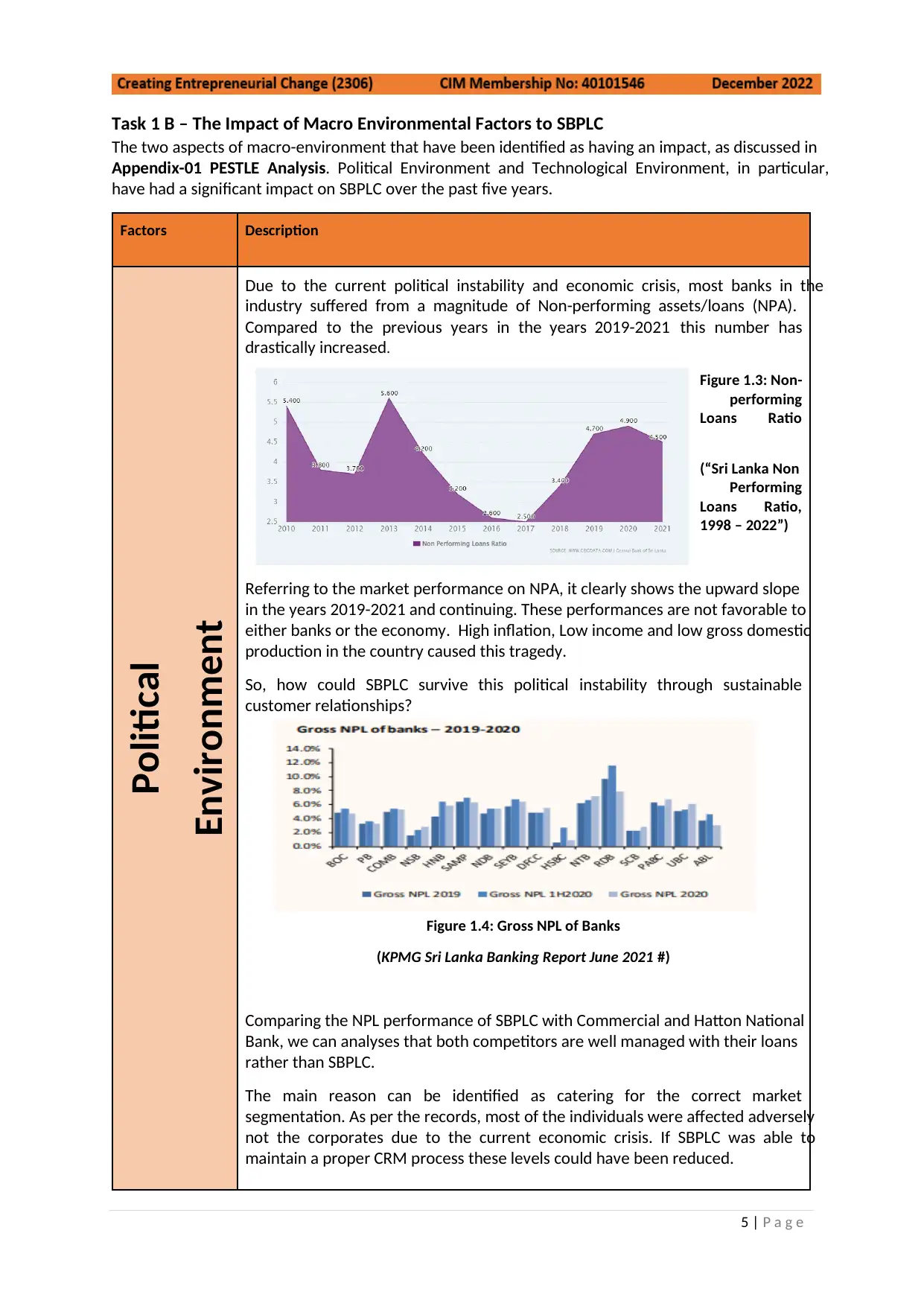
5 | P a g e
Task 1 B – The Impact of Macro Environmental Factors to SBPLC
The two aspects of macro-environment that have been identified as having an impact, as discussed in
Appendix-01 PESTLE Analysis. Political Environment and Technological Environment, in particular,
have had a significant impact on SBPLC over the past five years.
Factors Description
Political
Environment
Due to the current political instability and economic crisis, most banks in the
industry suffered from a magnitude of Non-performing assets/loans (NPA).
Compared to the previous years in the years 2019-2021 this number has
drastically increased.
Figure 1.3: Non-
performing
Loans Ratio
(“Sri Lanka Non
Performing
Loans Ratio,
1998 – 2022”)
Referring to the market performance on NPA, it clearly shows the upward slope
in the years 2019-2021 and continuing. These performances are not favorable to
either banks or the economy. High inflation, Low income and low gross domestic
production in the country caused this tragedy.
So, how could SBPLC survive this political instability through sustainable
customer relationships?
Figure 1.4: Gross NPL of Banks
(KPMG Sri Lanka Banking Report June 2021 #)
Comparing the NPL performance of SBPLC with Commercial and Hatton National
Bank, we can analyses that both competitors are well managed with their loans
rather than SBPLC.
The main reason can be identified as catering for the correct market
segmentation. As per the records, most of the individuals were affected adversely
not the corporates due to the current economic crisis. If SBPLC was able to
maintain a proper CRM process these levels could have been reduced.
Task 1 B – The Impact of Macro Environmental Factors to SBPLC
The two aspects of macro-environment that have been identified as having an impact, as discussed in
Appendix-01 PESTLE Analysis. Political Environment and Technological Environment, in particular,
have had a significant impact on SBPLC over the past five years.
Factors Description
Political
Environment
Due to the current political instability and economic crisis, most banks in the
industry suffered from a magnitude of Non-performing assets/loans (NPA).
Compared to the previous years in the years 2019-2021 this number has
drastically increased.
Figure 1.3: Non-
performing
Loans Ratio
(“Sri Lanka Non
Performing
Loans Ratio,
1998 – 2022”)
Referring to the market performance on NPA, it clearly shows the upward slope
in the years 2019-2021 and continuing. These performances are not favorable to
either banks or the economy. High inflation, Low income and low gross domestic
production in the country caused this tragedy.
So, how could SBPLC survive this political instability through sustainable
customer relationships?
Figure 1.4: Gross NPL of Banks
(KPMG Sri Lanka Banking Report June 2021 #)
Comparing the NPL performance of SBPLC with Commercial and Hatton National
Bank, we can analyses that both competitors are well managed with their loans
rather than SBPLC.
The main reason can be identified as catering for the correct market
segmentation. As per the records, most of the individuals were affected adversely
not the corporates due to the current economic crisis. If SBPLC was able to
maintain a proper CRM process these levels could have been reduced.
⊘ This is a preview!⊘
Do you want full access?
Subscribe today to unlock all pages.

Trusted by 1+ million students worldwide
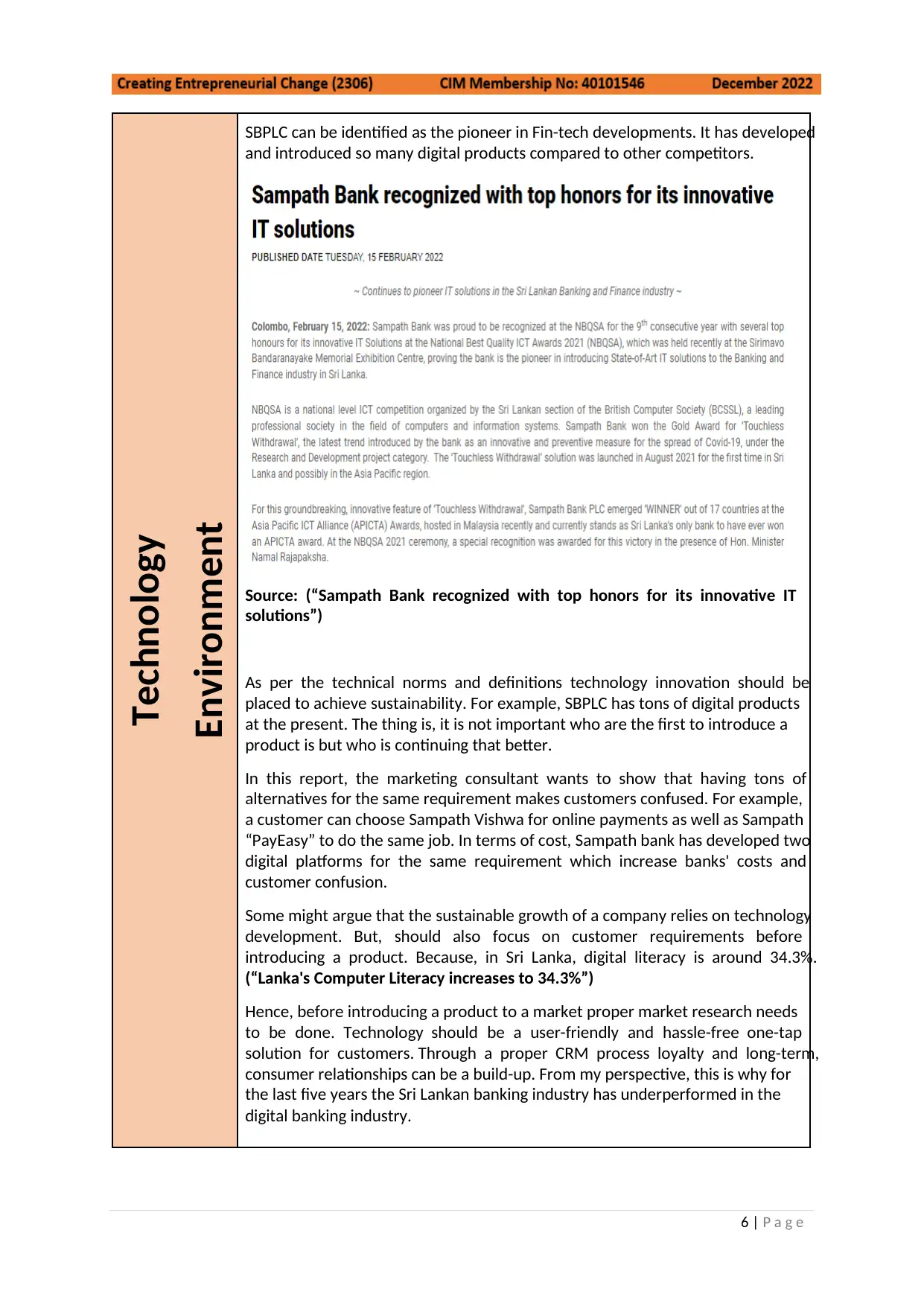
6 | P a g e
Technology
Environment
SBPLC can be identified as the pioneer in Fin-tech developments. It has developed
and introduced so many digital products compared to other competitors.
Source: (“Sampath Bank recognized with top honors for its innovative IT
solutions”)
As per the technical norms and definitions technology innovation should be
placed to achieve sustainability. For example, SBPLC has tons of digital products
at the present. The thing is, it is not important who are the first to introduce a
product is but who is continuing that better.
In this report, the marketing consultant wants to show that having tons of
alternatives for the same requirement makes customers confused. For example,
a customer can choose Sampath Vishwa for online payments as well as Sampath
“PayEasy” to do the same job. In terms of cost, Sampath bank has developed two
digital platforms for the same requirement which increase banks' costs and
customer confusion.
Some might argue that the sustainable growth of a company relies on technology
development. But, should also focus on customer requirements before
introducing a product. Because, in Sri Lanka, digital literacy is around 34.3%.
(“Lanka's Computer Literacy increases to 34.3%”)
Hence, before introducing a product to a market proper market research needs
to be done. Technology should be a user-friendly and hassle-free one-tap
solution for customers. Through a proper CRM process loyalty and long-term,
consumer relationships can be a build-up. From my perspective, this is why for
the last five years the Sri Lankan banking industry has underperformed in the
digital banking industry.
Technology
Environment
SBPLC can be identified as the pioneer in Fin-tech developments. It has developed
and introduced so many digital products compared to other competitors.
Source: (“Sampath Bank recognized with top honors for its innovative IT
solutions”)
As per the technical norms and definitions technology innovation should be
placed to achieve sustainability. For example, SBPLC has tons of digital products
at the present. The thing is, it is not important who are the first to introduce a
product is but who is continuing that better.
In this report, the marketing consultant wants to show that having tons of
alternatives for the same requirement makes customers confused. For example,
a customer can choose Sampath Vishwa for online payments as well as Sampath
“PayEasy” to do the same job. In terms of cost, Sampath bank has developed two
digital platforms for the same requirement which increase banks' costs and
customer confusion.
Some might argue that the sustainable growth of a company relies on technology
development. But, should also focus on customer requirements before
introducing a product. Because, in Sri Lanka, digital literacy is around 34.3%.
(“Lanka's Computer Literacy increases to 34.3%”)
Hence, before introducing a product to a market proper market research needs
to be done. Technology should be a user-friendly and hassle-free one-tap
solution for customers. Through a proper CRM process loyalty and long-term,
consumer relationships can be a build-up. From my perspective, this is why for
the last five years the Sri Lankan banking industry has underperformed in the
digital banking industry.
Paraphrase This Document
Need a fresh take? Get an instant paraphrase of this document with our AI Paraphraser
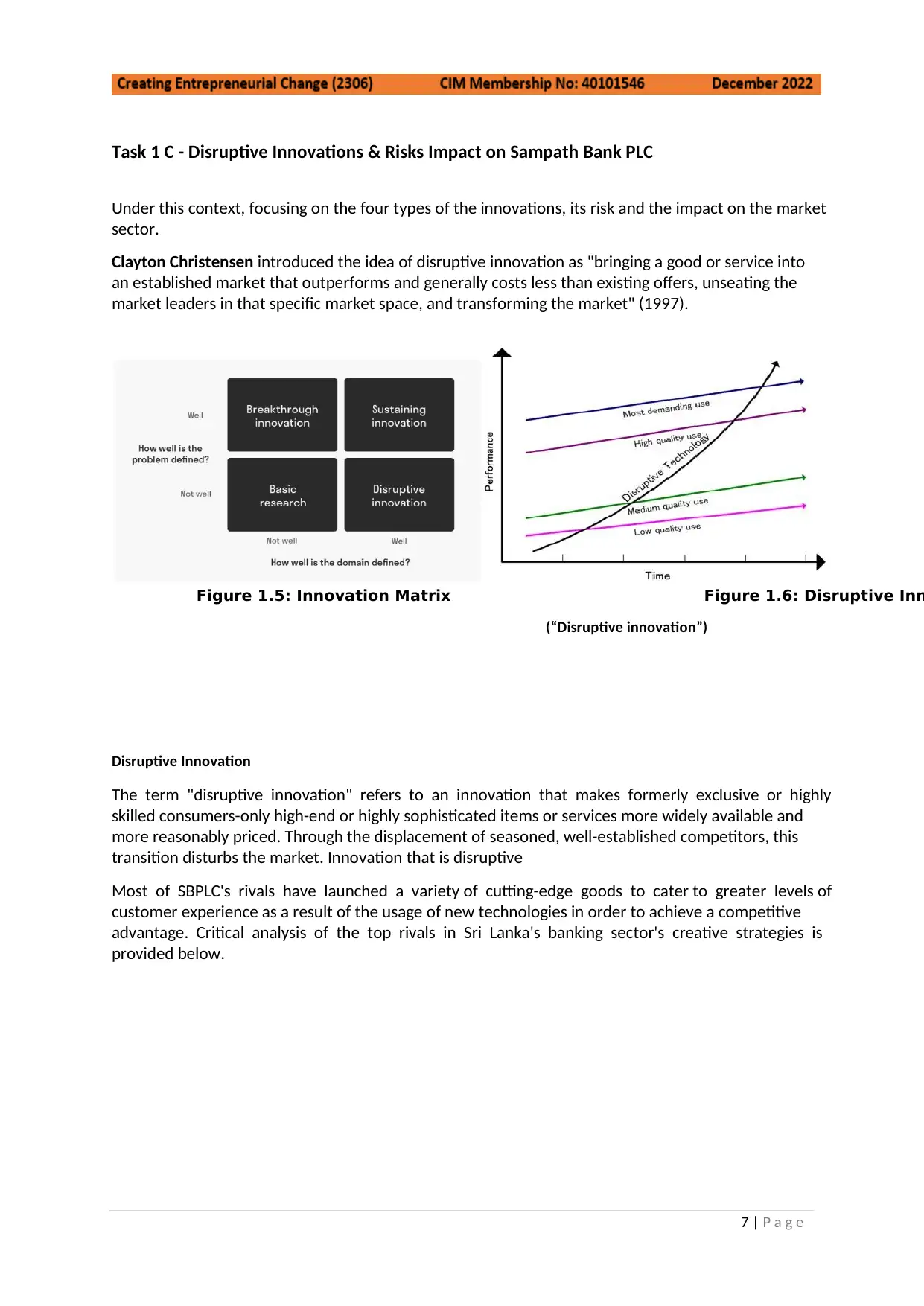
7 | P a g e
Task 1 C - Disruptive Innovations & Risks Impact on Sampath Bank PLC
Under this context, focusing on the four types of the innovations, its risk and the impact on the market
sector.
Clayton Christensen introduced the idea of disruptive innovation as "bringing a good or service into
an established market that outperforms and generally costs less than existing offers, unseating the
market leaders in that specific market space, and transforming the market" (1997).
Figure 1.5: Innovation Matrix Figure 1.6: Disruptive Inn
(“Disruptive innovation”)
Disruptive Innovation
The term "disruptive innovation" refers to an innovation that makes formerly exclusive or highly
skilled consumers-only high-end or highly sophisticated items or services more widely available and
more reasonably priced. Through the displacement of seasoned, well-established competitors, this
transition disturbs the market. Innovation that is disruptive
Most of SBPLC's rivals have launched a variety of cutting-edge goods to cater to greater levels of
customer experience as a result of the usage of new technologies in order to achieve a competitive
advantage. Critical analysis of the top rivals in Sri Lanka's banking sector's creative strategies is
provided below.
Task 1 C - Disruptive Innovations & Risks Impact on Sampath Bank PLC
Under this context, focusing on the four types of the innovations, its risk and the impact on the market
sector.
Clayton Christensen introduced the idea of disruptive innovation as "bringing a good or service into
an established market that outperforms and generally costs less than existing offers, unseating the
market leaders in that specific market space, and transforming the market" (1997).
Figure 1.5: Innovation Matrix Figure 1.6: Disruptive Inn
(“Disruptive innovation”)
Disruptive Innovation
The term "disruptive innovation" refers to an innovation that makes formerly exclusive or highly
skilled consumers-only high-end or highly sophisticated items or services more widely available and
more reasonably priced. Through the displacement of seasoned, well-established competitors, this
transition disturbs the market. Innovation that is disruptive
Most of SBPLC's rivals have launched a variety of cutting-edge goods to cater to greater levels of
customer experience as a result of the usage of new technologies in order to achieve a competitive
advantage. Critical analysis of the top rivals in Sri Lanka's banking sector's creative strategies is
provided below.
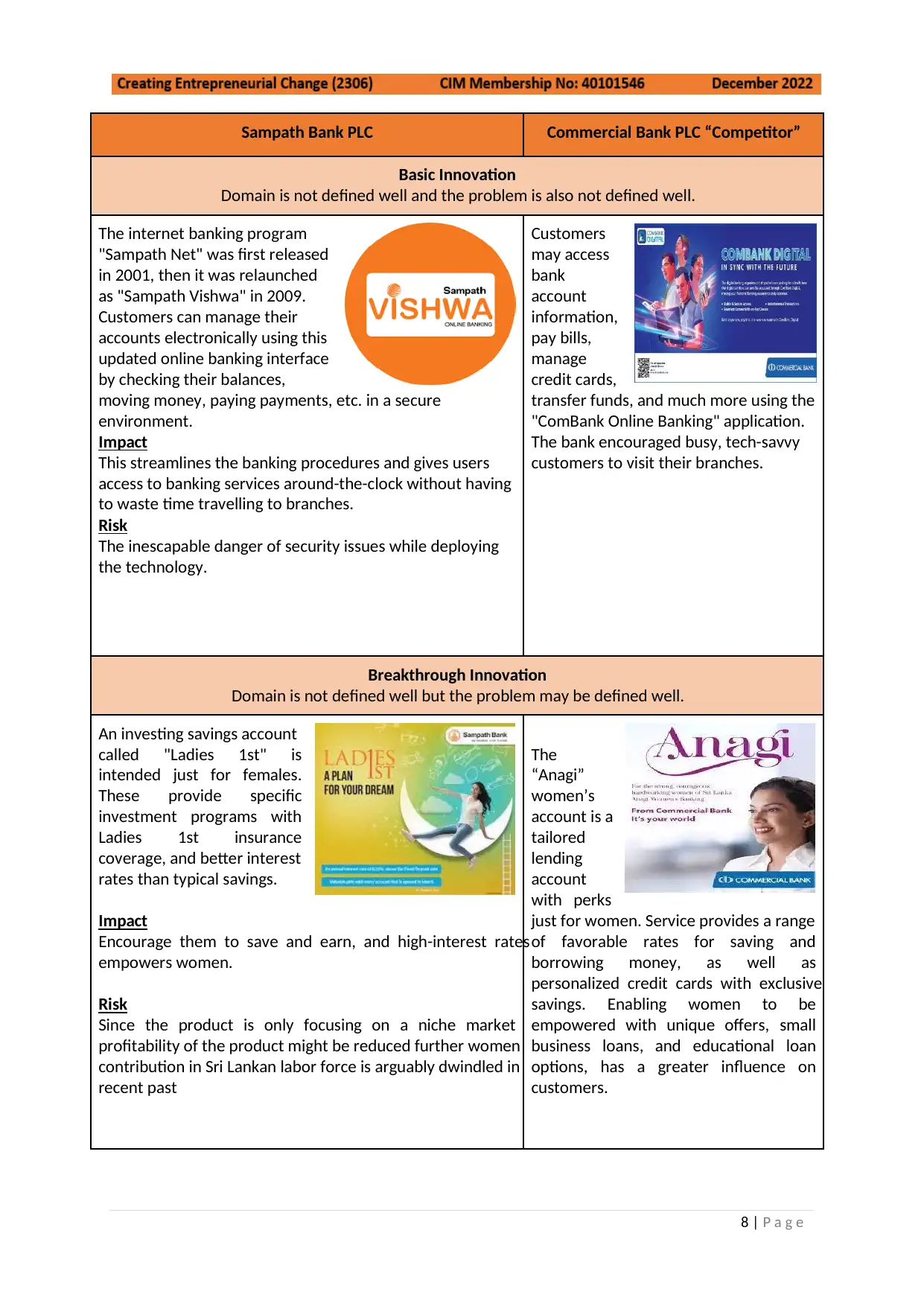
8 | P a g e
Sampath Bank PLC Commercial Bank PLC “Competitor”
Basic Innovation
Domain is not defined well and the problem is also not defined well.
The internet banking program
"Sampath Net" was first released
in 2001, then it was relaunched
as "Sampath Vishwa" in 2009.
Customers can manage their
accounts electronically using this
updated online banking interface
by checking their balances,
moving money, paying payments, etc. in a secure
environment.
Impact
This streamlines the banking procedures and gives users
access to banking services around-the-clock without having
to waste time travelling to branches.
Risk
The inescapable danger of security issues while deploying
the technology.
Customers
may access
bank
account
information,
pay bills,
manage
credit cards,
transfer funds, and much more using the
"ComBank Online Banking" application.
The bank encouraged busy, tech-savvy
customers to visit their branches.
Breakthrough Innovation
Domain is not defined well but the problem may be defined well.
An investing savings account
called "Ladies 1st" is
intended just for females.
These provide specific
investment programs with
Ladies 1st insurance
coverage, and better interest
rates than typical savings.
Impact
Encourage them to save and earn, and high-interest rates
empowers women.
Risk
Since the product is only focusing on a niche market
profitability of the product might be reduced further women
contribution in Sri Lankan labor force is arguably dwindled in
recent past
The
“Anagi”
women’s
account is a
tailored
lending
account
with perks
just for women. Service provides a range
of favorable rates for saving and
borrowing money, as well as
personalized credit cards with exclusive
savings. Enabling women to be
empowered with unique offers, small
business loans, and educational loan
options, has a greater influence on
customers.
Sampath Bank PLC Commercial Bank PLC “Competitor”
Basic Innovation
Domain is not defined well and the problem is also not defined well.
The internet banking program
"Sampath Net" was first released
in 2001, then it was relaunched
as "Sampath Vishwa" in 2009.
Customers can manage their
accounts electronically using this
updated online banking interface
by checking their balances,
moving money, paying payments, etc. in a secure
environment.
Impact
This streamlines the banking procedures and gives users
access to banking services around-the-clock without having
to waste time travelling to branches.
Risk
The inescapable danger of security issues while deploying
the technology.
Customers
may access
bank
account
information,
pay bills,
manage
credit cards,
transfer funds, and much more using the
"ComBank Online Banking" application.
The bank encouraged busy, tech-savvy
customers to visit their branches.
Breakthrough Innovation
Domain is not defined well but the problem may be defined well.
An investing savings account
called "Ladies 1st" is
intended just for females.
These provide specific
investment programs with
Ladies 1st insurance
coverage, and better interest
rates than typical savings.
Impact
Encourage them to save and earn, and high-interest rates
empowers women.
Risk
Since the product is only focusing on a niche market
profitability of the product might be reduced further women
contribution in Sri Lankan labor force is arguably dwindled in
recent past
The
“Anagi”
women’s
account is a
tailored
lending
account
with perks
just for women. Service provides a range
of favorable rates for saving and
borrowing money, as well as
personalized credit cards with exclusive
savings. Enabling women to be
empowered with unique offers, small
business loans, and educational loan
options, has a greater influence on
customers.
⊘ This is a preview!⊘
Do you want full access?
Subscribe today to unlock all pages.

Trusted by 1+ million students worldwide
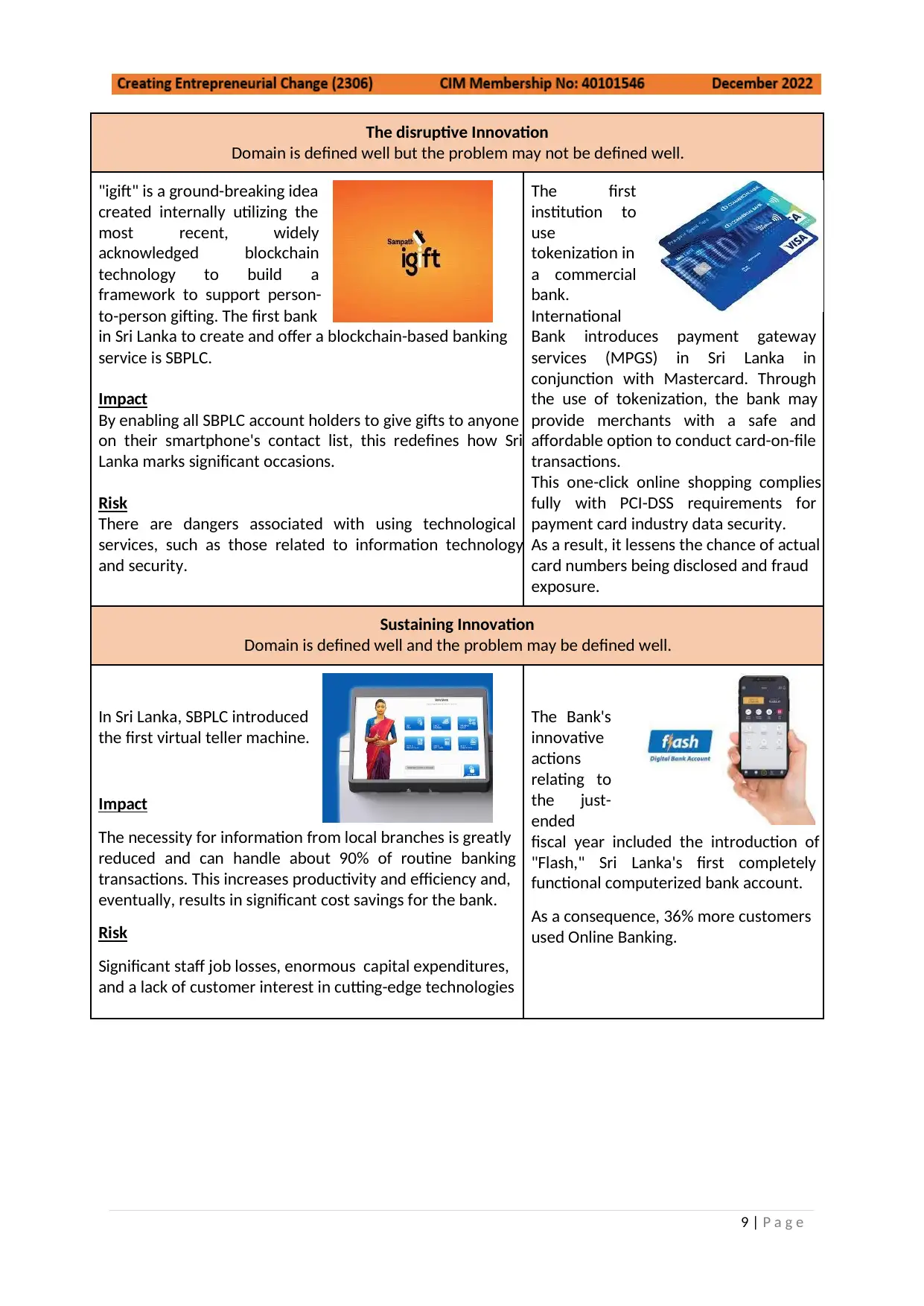
9 | P a g e
The disruptive Innovation
Domain is defined well but the problem may not be defined well.
"igift" is a ground-breaking idea
created internally utilizing the
most recent, widely
acknowledged blockchain
technology to build a
framework to support person-
to-person gifting. The first bank
in Sri Lanka to create and offer a blockchain-based banking
service is SBPLC.
Impact
By enabling all SBPLC account holders to give gifts to anyone
on their smartphone's contact list, this redefines how Sri
Lanka marks significant occasions.
Risk
There are dangers associated with using technological
services, such as those related to information technology
and security.
The first
institution to
use
tokenization in
a commercial
bank.
International
Bank introduces payment gateway
services (MPGS) in Sri Lanka in
conjunction with Mastercard. Through
the use of tokenization, the bank may
provide merchants with a safe and
affordable option to conduct card-on-file
transactions.
This one-click online shopping complies
fully with PCI-DSS requirements for
payment card industry data security.
As a result, it lessens the chance of actual
card numbers being disclosed and fraud
exposure.
Sustaining Innovation
Domain is defined well and the problem may be defined well.
In Sri Lanka, SBPLC introduced
the first virtual teller machine.
Impact
The necessity for information from local branches is greatly
reduced and can handle about 90% of routine banking
transactions. This increases productivity and efficiency and,
eventually, results in significant cost savings for the bank.
Risk
Significant staff job losses, enormous capital expenditures,
and a lack of customer interest in cutting-edge technologies
The Bank's
innovative
actions
relating to
the just-
ended
fiscal year included the introduction of
"Flash," Sri Lanka's first completely
functional computerized bank account.
As a consequence, 36% more customers
used Online Banking.
The disruptive Innovation
Domain is defined well but the problem may not be defined well.
"igift" is a ground-breaking idea
created internally utilizing the
most recent, widely
acknowledged blockchain
technology to build a
framework to support person-
to-person gifting. The first bank
in Sri Lanka to create and offer a blockchain-based banking
service is SBPLC.
Impact
By enabling all SBPLC account holders to give gifts to anyone
on their smartphone's contact list, this redefines how Sri
Lanka marks significant occasions.
Risk
There are dangers associated with using technological
services, such as those related to information technology
and security.
The first
institution to
use
tokenization in
a commercial
bank.
International
Bank introduces payment gateway
services (MPGS) in Sri Lanka in
conjunction with Mastercard. Through
the use of tokenization, the bank may
provide merchants with a safe and
affordable option to conduct card-on-file
transactions.
This one-click online shopping complies
fully with PCI-DSS requirements for
payment card industry data security.
As a result, it lessens the chance of actual
card numbers being disclosed and fraud
exposure.
Sustaining Innovation
Domain is defined well and the problem may be defined well.
In Sri Lanka, SBPLC introduced
the first virtual teller machine.
Impact
The necessity for information from local branches is greatly
reduced and can handle about 90% of routine banking
transactions. This increases productivity and efficiency and,
eventually, results in significant cost savings for the bank.
Risk
Significant staff job losses, enormous capital expenditures,
and a lack of customer interest in cutting-edge technologies
The Bank's
innovative
actions
relating to
the just-
ended
fiscal year included the introduction of
"Flash," Sri Lanka's first completely
functional computerized bank account.
As a consequence, 36% more customers
used Online Banking.
Paraphrase This Document
Need a fresh take? Get an instant paraphrase of this document with our AI Paraphraser
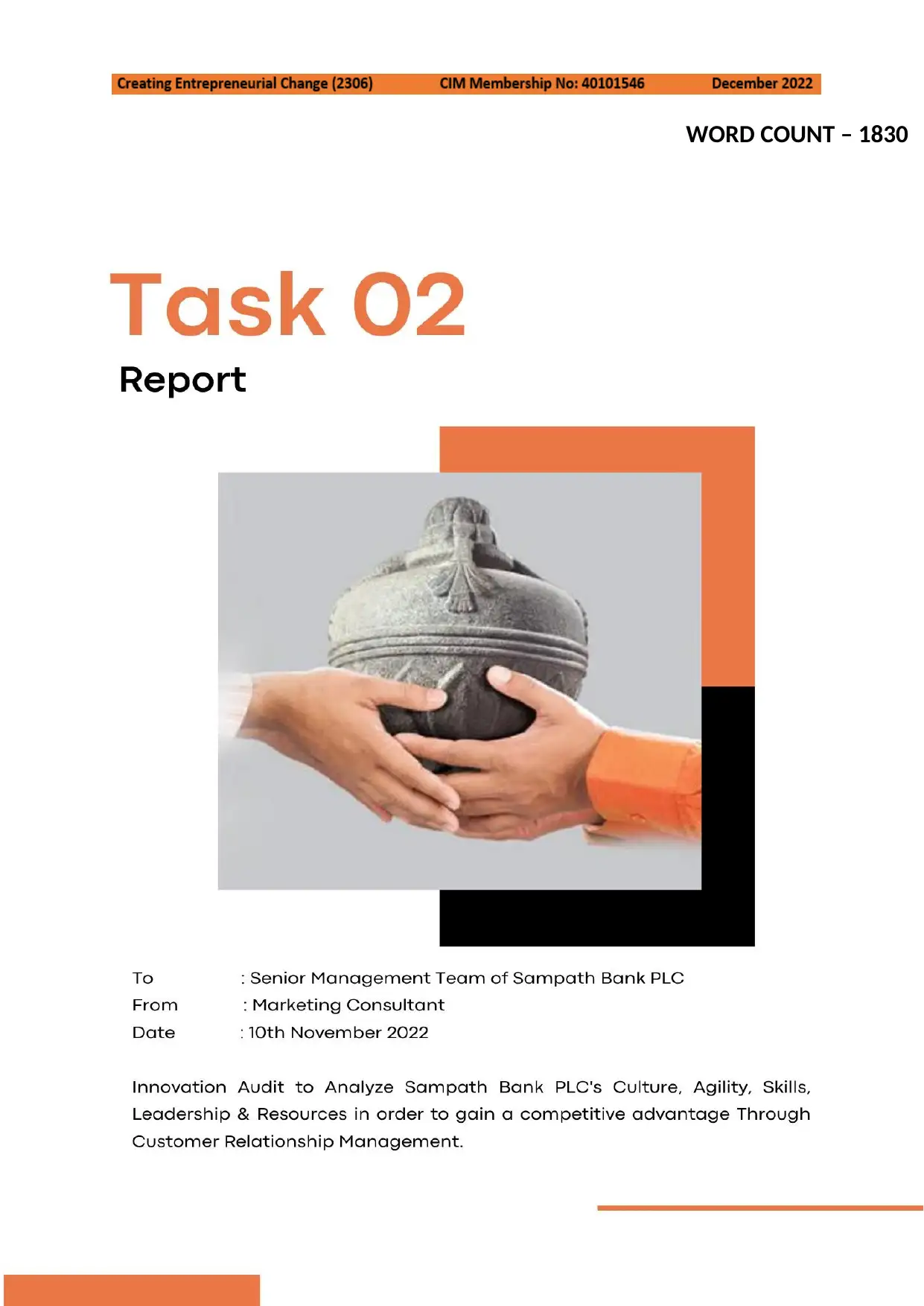
10 | P a g e
WORD COUNT – 1830
WORD COUNT – 1830
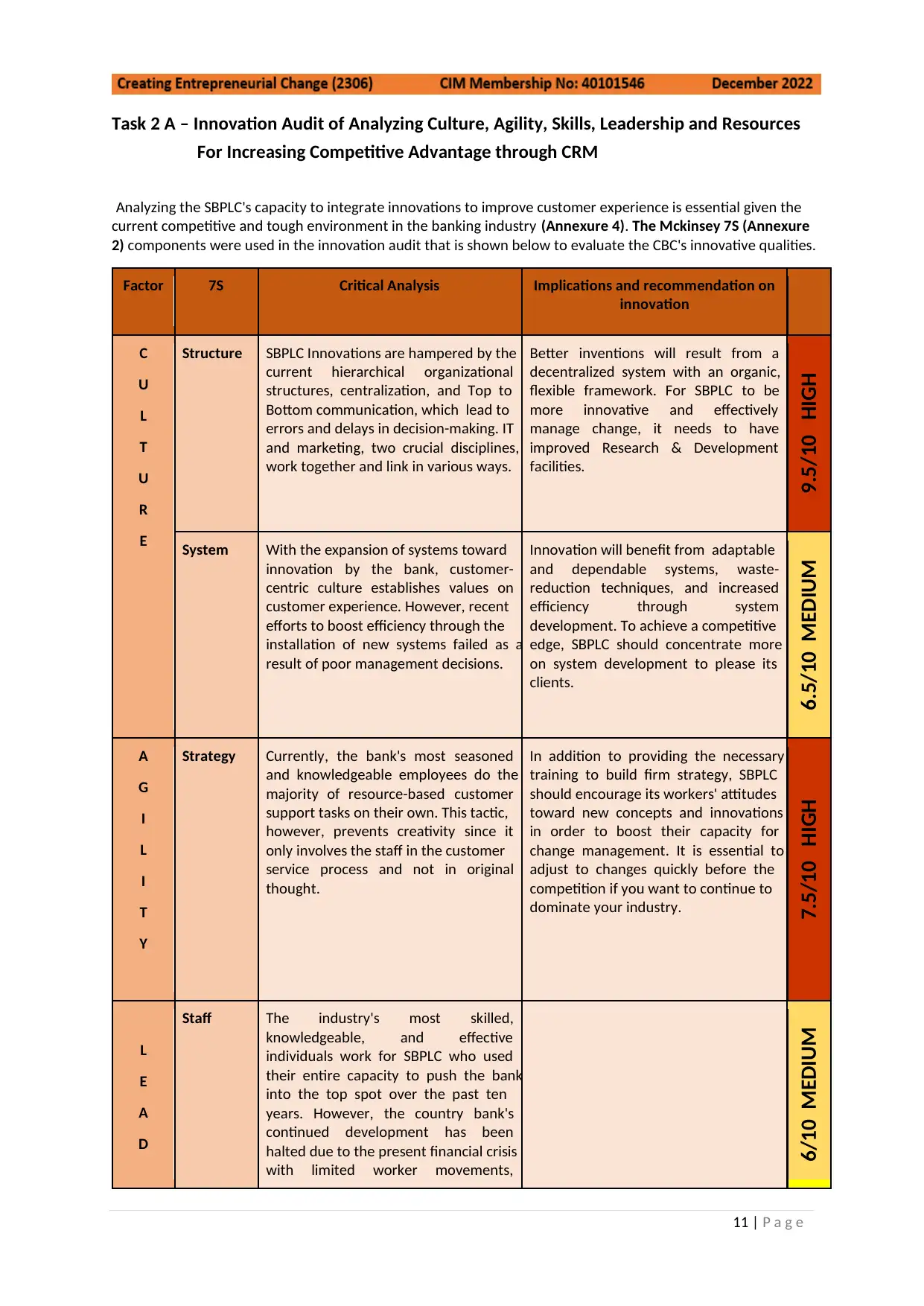
11 | P a g e
Task 2 A – Innovation Audit of Analyzing Culture, Agility, Skills, Leadership and Resources
For Increasing Competitive Advantage through CRM
Analyzing the SBPLC's capacity to integrate innovations to improve customer experience is essential given the
current competitive and tough environment in the banking industry (Annexure 4). The Mckinsey 7S (Annexure
2) components were used in the innovation audit that is shown below to evaluate the CBC's innovative qualities.
Factor 7S Critical Analysis Implications and recommendation on
innovation
C
U
L
T
U
R
E
Structure SBPLC Innovations are hampered by the
current hierarchical organizational
structures, centralization, and Top to
Bottom communication, which lead to
errors and delays in decision-making. IT
and marketing, two crucial disciplines,
work together and link in various ways.
Better inventions will result from a
decentralized system with an organic,
flexible framework. For SBPLC to be
more innovative and effectively
manage change, it needs to have
improved Research & Development
facilities.
9.5/10 HIGH
System With the expansion of systems toward
innovation by the bank, customer-
centric culture establishes values on
customer experience. However, recent
efforts to boost efficiency through the
installation of new systems failed as a
result of poor management decisions.
Innovation will benefit from adaptable
and dependable systems, waste-
reduction techniques, and increased
efficiency through system
development. To achieve a competitive
edge, SBPLC should concentrate more
on system development to please its
clients.
6.5/10 MEDIUM
A
G
I
L
I
T
Y
Strategy Currently, the bank's most seasoned
and knowledgeable employees do the
majority of resource-based customer
support tasks on their own. This tactic,
however, prevents creativity since it
only involves the staff in the customer
service process and not in original
thought.
In addition to providing the necessary
training to build firm strategy, SBPLC
should encourage its workers' attitudes
toward new concepts and innovations
in order to boost their capacity for
change management. It is essential to
adjust to changes quickly before the
competition if you want to continue to
dominate your industry.
7.5/10 HIGH
L
E
A
D
Staff The industry's most skilled,
knowledgeable, and effective
individuals work for SBPLC who used
their entire capacity to push the bank
into the top spot over the past ten
years. However, the country bank's
continued development has been
halted due to the present financial crisis
with limited worker movements,
6/10 MEDIUM
Task 2 A – Innovation Audit of Analyzing Culture, Agility, Skills, Leadership and Resources
For Increasing Competitive Advantage through CRM
Analyzing the SBPLC's capacity to integrate innovations to improve customer experience is essential given the
current competitive and tough environment in the banking industry (Annexure 4). The Mckinsey 7S (Annexure
2) components were used in the innovation audit that is shown below to evaluate the CBC's innovative qualities.
Factor 7S Critical Analysis Implications and recommendation on
innovation
C
U
L
T
U
R
E
Structure SBPLC Innovations are hampered by the
current hierarchical organizational
structures, centralization, and Top to
Bottom communication, which lead to
errors and delays in decision-making. IT
and marketing, two crucial disciplines,
work together and link in various ways.
Better inventions will result from a
decentralized system with an organic,
flexible framework. For SBPLC to be
more innovative and effectively
manage change, it needs to have
improved Research & Development
facilities.
9.5/10 HIGH
System With the expansion of systems toward
innovation by the bank, customer-
centric culture establishes values on
customer experience. However, recent
efforts to boost efficiency through the
installation of new systems failed as a
result of poor management decisions.
Innovation will benefit from adaptable
and dependable systems, waste-
reduction techniques, and increased
efficiency through system
development. To achieve a competitive
edge, SBPLC should concentrate more
on system development to please its
clients.
6.5/10 MEDIUM
A
G
I
L
I
T
Y
Strategy Currently, the bank's most seasoned
and knowledgeable employees do the
majority of resource-based customer
support tasks on their own. This tactic,
however, prevents creativity since it
only involves the staff in the customer
service process and not in original
thought.
In addition to providing the necessary
training to build firm strategy, SBPLC
should encourage its workers' attitudes
toward new concepts and innovations
in order to boost their capacity for
change management. It is essential to
adjust to changes quickly before the
competition if you want to continue to
dominate your industry.
7.5/10 HIGH
L
E
A
D
Staff The industry's most skilled,
knowledgeable, and effective
individuals work for SBPLC who used
their entire capacity to push the bank
into the top spot over the past ten
years. However, the country bank's
continued development has been
halted due to the present financial crisis
with limited worker movements,
6/10 MEDIUM
⊘ This is a preview!⊘
Do you want full access?
Subscribe today to unlock all pages.

Trusted by 1+ million students worldwide
1 out of 33
Your All-in-One AI-Powered Toolkit for Academic Success.
+13062052269
info@desklib.com
Available 24*7 on WhatsApp / Email
![[object Object]](/_next/static/media/star-bottom.7253800d.svg)
Unlock your academic potential
Copyright © 2020–2025 A2Z Services. All Rights Reserved. Developed and managed by ZUCOL.

